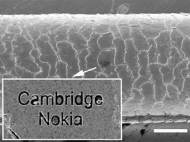Nokia Research Centre in Cambridge reveals some of their research
 The Nokia Research Center in Cambridge was set up in 2007 as a partnership with the University of Cambridge. Soon after it was established, the Morph Concept was unveiled, to help build a picture of where the research at the labs was heading. They recently demoed three different strands of their research and those are nanowire sensing, stretchable electronic skin and electrotactile experience.
The Nokia Research Center in Cambridge was set up in 2007 as a partnership with the University of Cambridge. Soon after it was established, the Morph Concept was unveiled, to help build a picture of where the research at the labs was heading. They recently demoed three different strands of their research and those are nanowire sensing, stretchable electronic skin and electrotactile experience.
Led by Dr Tapani Ryhänen the Cambridge team is one part of a two-location European NRC operation (the other location being in Lausanne, Switzerland). The focus of the research though is very much around nanotechnology and executing what Dr Tapani refers to as “meaningful engineering at a smaller scale”.
The team involved in nanowire sensing is effectively working on an artificial nose. By placing a nanowire on top of a chip, they can train it to recognise different substances which are placed close to the sensing surface. This all happens at a nanometer scale, where the current passing through the nanowire is influenced by its immediate surroundings.
When you place a different substance near it the current running through the wire will react differently. There’s still a lot of work to do on it, but the team were able to demonstrate the operation of the nanowire and its accompanying software (which used a sniffing dog as its icon) correctly identify a substance. Right now it’s restricted to identifying particular molecules but the long term aim is to enable it to identify complex molecular mixtures (similar to how our own noses work).
Another team at the University of Cambridge and NRC are working on stretchable electronic skin that could enable new hardware and interfaces to be flexibl. By using evaporated gold as a conductor, they have created an electronic touchpad which can be stretched like a rubber band, but still respond to touch and pressure. The team has been testing it to stretch by up to 20 percent of its original length without any drop in performance.
The third team is working on ways to enable touchscreens to offer more realistic feedback. Part of the team’s research is looking at ways to try and replicate textures, potentially offering users new experiences when it comes to interacting with a touchscreen. Using the concept of electrovibration, which was first documented in the 1950s, the team has been working on the concept that could change the way we interact with gadgets.









Leave your response!